Resveratrol inhibits nicotinic stimulation-evoked catecholamine release from the adrenal medulla
- PMID: 19967050
- PMCID: PMC2788630
- DOI: 10.4196/kjpp.2008.12.4.155
Resveratrol inhibits nicotinic stimulation-evoked catecholamine release from the adrenal medulla
Abstract
Resveratrol has been known to possess various potent cardiovascular effects in animal, but there is little information on its functional effect on the secretion of catecholamines (CA) from the perfused model of the adrenal medulla. Therefore, the aim of the present study was to determine the effect of resveratrol on the CA secretion from the isolated perfused model of the normotensive rat adrenal gland, and to elucidate its mechanism of action. Resveratrol (10~100microM) during perfusion into an adrenal vein for 90 min inhibited the CA secretory responses evoked by ACh (5.32 mM), high K(+) (a direct membrane-depolarizer, 56 mM), DMPP (a selective neuronal nicotinic N(n) receptor agonist, 100microM) and McN-A-343 (a selective muscarinic M(1) receptor agonist, 100microM) in both a time- and dose-dependent fashion. Also, in the presence of resveratrol (30microM), the secretory responses of CA evoked by veratridine 8644 (an activator of voltage-dependent Na(+) channels, 100microM), Bay-K-8644 (a L-type dihydropyridine Ca(2+) channel activator, 10microM), and cyclopiazonic acid (a cytoplasmic Ca(2+)-ATPase inhibitor, 10microM) were significantly reduced. In the simultaneous presence of resveratrol (30microM) and L-NAME (an inhibitor of NO synthase, 30microM), the CA secretory evoked by ACh, high K(+) , DMPP, McN-A-343, Bay-K-8644 and cyclopiazonic acid were recovered to a considerable extent of the corresponding control secretion compared with the inhibitory effect of resveratrol alone. Interestingly, the amount of nitric oxide (NO) released from the adrenal medulla was greatly increased in comparison to its basal release. Taken together, these experimental results demonstrate that resveratrol can inhibit the CA secretory responses evoked by stimulation of cholinergic nicotinic receptors, as well as by direct membrane-depolarization in the isolated perfused model of the rat adrenal gland. It seems that this inhibitory effect of resveratrol is exerted by inhibiting an influx of both ions through Na(+) and Ca(2+) channels into the adrenomedullary cells as well as by blocking the release of Ca(2+) from the cytoplasmic calcium store, which are mediated at least partly by the increased NO production due to the activation of NO synthase.
Keywords: Adrenal medulla; Catecholamine secretion; Cholinergic receptors; Nitric oxide; Resveratrol.
Figures

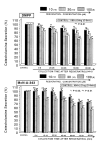
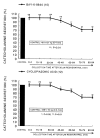

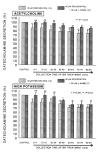
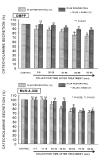
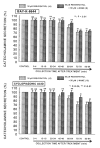

Similar articles
-
Provinol inhibits catecholamine secretion from the rat adrenal medulla.Korean J Physiol Pharmacol. 2009 Jun;13(3):229-39. doi: 10.4196/kjpp.2009.13.3.229. Epub 2009 Jun 30. Korean J Physiol Pharmacol. 2009. PMID: 19885042 Free PMC article.
-
Inhibitory Effects of Total Ginseng Saponin on Catecholamine Secretion from the Perfused Adrenal Medulla of SHRs.J Ginseng Res. 2011 Jun;35(2):176-90. doi: 10.5142/jgr.2011.35.2.176. J Ginseng Res. 2011. PMID: 23717060 Free PMC article.
-
Influence of ketamine on catecholamine secretion in the perfused rat adrenal medulla.Korean J Physiol Pharmacol. 2008 Jun;12(3):101-9. doi: 10.4196/kjpp.2008.12.3.101. Epub 2008 Jun 30. Korean J Physiol Pharmacol. 2008. PMID: 20157402 Free PMC article.
-
Influence of polyphenolic compounds isolated from Rubus coreanum on catecholamine release in the rat adrenal medulla.Arch Pharm Res. 2007 Oct;30(10):1240-51. doi: 10.1007/BF02980265. Arch Pharm Res. 2007. PMID: 18038903
-
Use of isolated chromaffin cells to study basic release mechanisms.J Auton Nerv Syst. 1983 Jan;7(1):59-86. doi: 10.1016/0165-1838(83)90069-3. J Auton Nerv Syst. 1983. PMID: 6188774 Review.
Cited by
-
Sex/Gender- and Age-Related Differences in β-Adrenergic Receptor Signaling in Cardiovascular Diseases.J Clin Med. 2022 Jul 22;11(15):4280. doi: 10.3390/jcm11154280. J Clin Med. 2022. PMID: 35893368 Free PMC article. Review.
-
Short-term supplementation with a specific combination of dietary polyphenols increases energy expenditure and alters substrate metabolism in overweight subjects.Int J Obes (Lond). 2014 May;38(5):698-706. doi: 10.1038/ijo.2013.231. Epub 2013 Dec 9. Int J Obes (Lond). 2014. PMID: 24317366 Clinical Trial.
-
Provinol inhibits catecholamine secretion from the rat adrenal medulla.Korean J Physiol Pharmacol. 2009 Jun;13(3):229-39. doi: 10.4196/kjpp.2009.13.3.229. Epub 2009 Jun 30. Korean J Physiol Pharmacol. 2009. PMID: 19885042 Free PMC article.
References
-
- Andriambeloson E, Magnier C, Haan-Archipoff G, Lobstein A, Anton R, Beretz A, Stoclet JC, Andriantsitohaina R. Natural dietary polyphenolic compounds cause endothelium-dependent vasorelaxation in rat thoracic aorta. J Nutr. 1998;128:2324–2333. - PubMed
-
- Andriambeloson E, Stoclet JC, Andriantsitohaina R. Mechanism of endothelial nitric oxide-dependent vasorelaxation induced by wine polyphenols in rat thoracic aorta. J Cardiovasc Pharmacol. 1999;33:248–254. - PubMed
-
- Anton AH, Sayre DF. A study of the factors affecting the aluminum oxide trihydroxy indole procedure for the analysis of catecholamines. J Pharmacol Exp Ther. 1962;138:360–375. - PubMed
-
- Bernatova I, Pecháòová O, Babál P, Kyselá S, Stvrtina S, Andriantsitohaina R. Wine polyphenols improve cardiovascular remodelling and vascular function in NO-deficient hypertension. Am J Physiol Heart Circ Physiol. 2002;282:H942–H948. - PubMed
LinkOut - more resources
Full Text Sources
Other Literature Sources
Medical
Miscellaneous

